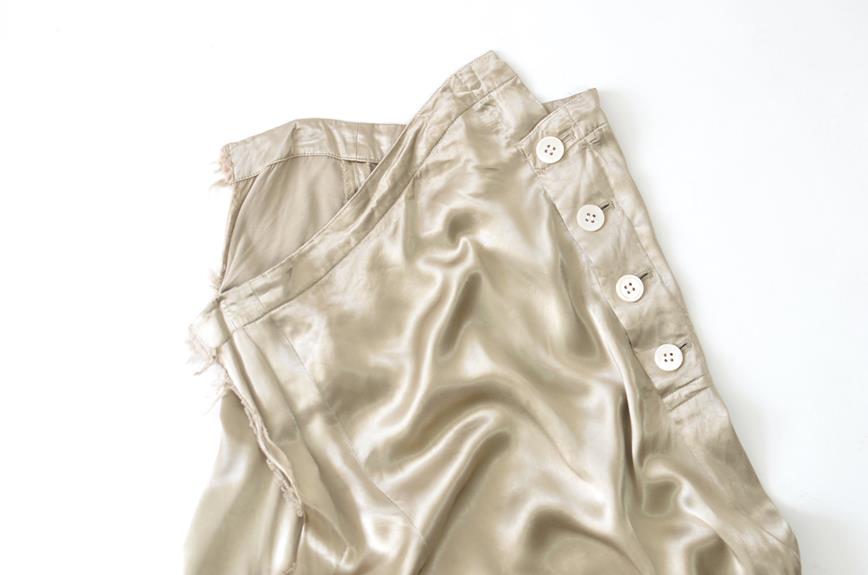Are fraying edges destroying your fabric? You've probably heard various theories on how to prevent and fix fraying, but are they really effective?
In this guide, we'll explore proven solutions to combat fabric fraying and help you master the art of preserving your textiles. From essential tools for fray prevention to sewing machine stitches for fray control, we'll cover it all.
Whether you're a seasoned seamstress or just starting out, these techniques will empower you to keep your fabric edges intact and avoid the frustration of fraying. Let's dive in and discover the best ways to protect your fabric from fraying.
Key Takeaways
- Fraying occurs when the fibers of a fabric unravel and separate from the main weave.
- Proactive measures like using pinking shears and applying serging stitches can prevent fraying.
- Fray prevention products like fray check or seam sealant can effectively seal fabric edges.
- Regularly inspect fabric edges and promptly address fraying issues to prevent further damage.
Understanding Fabric Fraying
If fraying is a recurring issue with your fabrics, understanding the causes and characteristics of fabric fraying can help you address the problem effectively. Fraying occurs when the individual fibers of a fabric start to unravel and separate from the main weave. This can happen due to various reasons such as the type of fabric, the weave structure, or the fabric's exposure to friction or abrasion. Understanding the mechanics of fraying can help you identify the specific factors contributing to the issue with your fabrics.
To address fraying, it's essential to consider fabric preservation techniques. These techniques involve taking proactive measures to prevent fraying, such as using pinking shears to create zigzag edges that are less prone to unraveling, applying serging or overlocking stitches to the fabric edges, or using fabric adhesives to secure the fibers in place. Additionally, choosing fabrics with tighter weaves or incorporating interfacing can also help minimize fraying.
Essential Tools for Fray Prevention
Hey there, let's talk about the essential tools for preventing fabric fraying.
First off, there's Fray-Check, a handy solution for reinforcing fabric edges.
You might also want to consider using seam sealants or investing in a serger for a professional finish.
Fray-Check for Edges
To prevent fraying edges on your fabric, consider using Fray-Check as an essential tool for fray prevention. Fray-Check is a clear liquid seam sealant that helps prevent fabric edges from fraying and unraveling.
Here are three ways Fray-Check can help you maintain the integrity of your fabric edges:
- Sealing Edges: Apply Fray-Check along the edges of your fabric to create a protective barrier that prevents fraying.
- Reinforcing Seams: Use Fray-Check to reinforce the seams of your fabric, ensuring that they remain strong and intact.
- Finishing Touch: After hemming or trimming your fabric, apply Fray-Check to the edges for a clean, professional finish that resists fraying.
Using Fray-Check as part of your fabric care routine can significantly reduce the risk of fraying, keeping your fabric looking neat and well-maintained.
Seam Sealant Options
Considering seam sealant options is crucial for preventing fraying edges on your fabric, ensuring the longevity and integrity of your projects. Fray prevention is essential for maintaining the quality of your creations.
When it comes to edge sealing, there are various seam sealant options available, each with unique features and application methods. Some popular choices include liquid seam sealants, tape sealants, and adhesive sealants.
Liquid seam sealants are applied directly to the fabric edges, creating a protective barrier against fraying.
Tape sealants offer convenience with their easy application and are ideal for quick fixes.
Adhesive sealants provide a strong bond while preventing fraying.
Understanding the specific needs of your project will help you choose the most suitable seam sealant option for effective fray prevention and long-lasting results.
Serger for Finishing
Wondering how you can effectively prevent fraying edges on your fabric? Consider using a serger for finishing, which is an essential tool for fray prevention. Here are some serger techniques and edge reinforcement methods to help you achieve professional-looking, fray-free edges:
- Three-Thread Overlock: Use a three-thread overlock stitch on your serger to encase the raw edge of the fabric, preventing fraying and ensuring a clean finish.
- Edge Reinforcement: For extra durability, consider reinforcing the edges of your fabric by using a serger to sew a narrow, tight overlock stitch along the edge.
- Differential Feed Adjustment: When working with different fabric types, make use of the serger's differential feed adjustment to prevent stretching and puckering, resulting in neatly finished edges.
Mastering these serger techniques and edge reinforcement methods will help you achieve professional, fray-free results in your sewing projects.
Techniques for Sealing Frayed Edges
You can effectively seal frayed edges using a clear fabric glue. Fabric sealing with clear fabric glue is a simple and efficient way to prevent fraying and maintain the integrity of your fabric. To start, lay your fabric on a flat surface and carefully apply a small amount of clear fabric glue along the frayed edge. Use a cotton swab or a small brush to evenly spread the glue, ensuring that all frayed threads are coated. Allow the glue to dry completely before handling the fabric to ensure a secure seal.
Another technique for preventing frayed edges is using fray prevention products such as fray check or seam sealant. These products are specifically designed to seal fabric edges and prevent fraying. Simply apply a small amount along the frayed edge and let it dry thoroughly. Fray prevention products are especially useful for fabrics that are prone to fraying, such as woven materials.
Sewing Machine Stitches for Fray Control
To control fraying edges, start by selecting a tight zigzag stitch on your sewing machine. This versatile stitch works wonders in preventing fraying and can be adjusted to suit the thickness of your fabric.
Here are three essential sewing machine stitches for fray control:
- Zigzag Stitch: Set your machine to a narrow zigzag stitch for lightweight fabrics and a wider zigzag for heavier materials. The zigzag stitch creates a flexible edge that inhibits fraying and is particularly effective for finishing raw edges.
- Satin Stitch: This dense and close-set zigzag stitch is ideal for securing fabric edges and preventing fraying. Adjust the stitch width and length to achieve the desired satin stitch effect. It's especially effective for delicate fabrics that require a fine finish.
- Overlock Stitch: If your sewing machine has an overlock or serger stitch option, utilize it to neatly encase the fabric edges, providing a professional and durable finish that prevents fraying.
These machine stitches offer effective solutions for fray prevention and edge finishing, ensuring your fabric edges remain intact and polished.
Alternative Methods for Fray Management
Consider using a silicone-based fray stop liquid to effectively manage fraying edges on your fabric. This alternative method for fray management provides a simple and efficient solution to prevent further unraveling and maintain the integrity of your fabric. The liquid creates a clear, flexible coating that dries quickly, effectively sealing the edges and preventing fraying. Here are some options for fray repair and fabric preservation using silicone-based fray stop liquids:
| Brand | Application | Drying Time |
|---|---|---|
| Fray Block | Brush or Pen | 15-30 minutes |
| Aleene's Stop-Fray | Bottle with Applicator | 2-4 hours |
| Dritz Fray Check | Bottle with Applicator | 24 hours |
These products offer varying application methods and drying times, allowing you to choose the most convenient option based on your specific needs. Whether you prefer a brush, pen, or bottle with an applicator, there's a silicone-based fray stop liquid that can provide effective fray repair and fabric preservation.
Tips for Maintaining Fray-Free Fabric
For maintaining fray-free fabric, it's essential to regularly inspect your fabric's edges for any signs of fraying and promptly address any issues to prevent further damage. Preventing fraying and caring for your fabric properly can extend its lifespan and keep it looking fresh and new. Here are some tips for maintaining fray-free fabric:
- Seal the Edges: Use a fray prevention solution, such as fray check or fabric glue, to seal the edges of your fabric and prevent fraying. Apply a small amount to the edges and let it dry completely before handling the fabric.
- Use Pinking Shears: When cutting fabric, consider using pinking shears to create a zigzag edge. This can help minimize fraying as the zigzag pattern reduces the amount of fabric that can unravel.
- Serging or Overlocking: If you have a serger or overlock machine, finish the raw edges of your fabric with a serged or overlocked stitch. This type of stitch encases the raw edges, preventing fraying and providing a clean, professional finish.
Troubleshooting Fraying Issues
Inspect the fraying edges of your fabric to identify the root cause of the issue and implement targeted solutions for preventing further damage. Fraying can occur due to various reasons such as fabric type, weaving technique, or improper handling.
To troubleshoot fraying, start by examining the frayed areas to determine the extent of the damage. If the fraying is minimal, you may consider using fray prevention methods such as applying fray check solutions or using a sewing machine to create a zigzag stitch along the edges. This will help secure the edges and prevent further unraveling.
For more significant fraying, edge sealing could be the solution. Edge sealing involves using products like fabric glue, clear nail polish, or specially designed edge sealants to seal the edges and stop fraying. Ensure that the chosen method aligns with the fabric type and intended use.
Frequently Asked Questions
Can I Prevent Fraying Without Using a Sewing Machine?
You can prevent fraying without using a sewing machine through various no sew techniques like fabric glue, fray check, or hemming tape. These methods provide effective fabric fray prevention without requiring a sewing machine.
What Are Some Long-Term Solutions for Preventing Fraying?
To prevent fraying long-term without a sewing machine, you can use fabric glue or hand stitching to secure the edges. These no sew solutions offer effective ways to stop fraying and keep your fabric intact for an extended period.
How Can I Fix Frayed Edges on Delicate or Intricate Fabrics?
To fix frayed edges on delicate or intricate fabrics, try using fabric glue or hand stitching for a seamless repair. For added protection, consider using fray check or fabric sealant to prevent future fraying.
Are There Any Natural or Eco-Friendly Methods for Preventing Fraying?
To prevent fraying with natural remedies, try using eco-friendly alternatives like beeswax or aloe vera gel. These can create a protective barrier on the fabric edges, reducing fraying without harmful chemicals.
What Are Some Common Mistakes That Lead to Fabric Fraying, and How Can I Avoid Them?
To avoid fabric fraying, focus on fabric care and prevention. Common mistakes like using the wrong thread tension or not finishing edges can lead to fraying. Choose appropriate fabric, use quality thread, and finish edges properly.
- How Does Ring Spun Cotton Affect Garment Fit and Shape Retention? - August 13, 2024
- What Are the Challenges in Producing Ring Spun Cotton? - August 13, 2024
- Is Ring Spun Cotton Suitable for Plus-Size Clothing? - August 13, 2024





